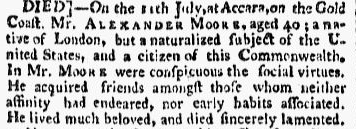I'll start with the
story of Ruth Lovis, my fifth great-grandmother. I first learned of her in the
memoirs of my great-great-grandmother Mary (Huggins) Sprott. Mary wrote
"John Scott’s wife was an American, Grannie said her name was Lovelace. She was a young widow and came to
England about some lawsuit. John Scott was her lawyer, won the case and the
widow. Grannie said she came from Boston . . ."
It took a while for
me to identify Ruth since her surname was Lovis, not Lovelace. I found that she
was indeed from Boston, with deep colonial roots that go back to early days in
Plymouth, Massachusetts. Her parents were Thomas Lovis and Ruth Mansfield. In
1789, when Ruth was about 21, she married Alexander Moore, a ship's cargo
master. Barely two weeks later, Alexander embarked on a lengthy shipping voyage
from which he never returned. In 1791, while still on the journey, he died.
 |
| The Independent Chronicle, Nov 24, 1791, Vol XXIII, Issue 1204, page 3, Boston |
Alexander Moore’s
estate was administered both in Boston and in Canterbury, England. Apparently,
Ruth did go to London since on October 1, 1794, Ruth Moore, a widow, married
John Scott at St. Pancras parish church in London, England. Ruth was of the parish of St. Pancras, while John was of the parish of St. Mildred Poultry.
 |
London Metropolitan Archives, Saint Pancras Parish Church, Register of marriages, P90/PAN1, Item 055. Ancestry.com.
|
John Scott operated
a law practice and was said to be a King's Counsel, a barrister of the highest
rank. In 1794, he was 31 years old and listed in Kent's London Directory as an
attorney at 6 St. Mildred's-court, Poultry. St. Mildred's Court was a short dead
end lane just east of St. Mildred's Church, located in the heart of London in
an area known as "the City." The Bank of England, the Mansion House,
and the Exchange are in the immediate vicinity. The Scott law offices remained
at this address for about 50 years, well into the 1840s. I assume they also had living
quarters here.
 |
| 1795 St. Mildred's Court is left of the Bank of England. |
 |
| 1872 |
St. Mildred's Church was
demolished in 1874. Here's how the area looked in 2007, when I visited.
St. Mildred's Court
is the alley between the two buildings. A close up view of the alley:
This sculpture is on
the building that stands where the church was, a reminder of the medieval history of the location as the center of the poultry market.
Notes and Sources:
1) The Memoirs of Mary Constance (Huggins) Sprott, privately published, are in our family's personal library.
2) In the second paragraph, "Grannie" is a
reference to Sarah Hamer (Scott) Clarkson, a daughter of John and Ruth
(Lovis) Scott.



